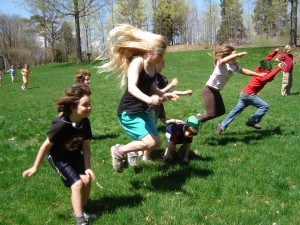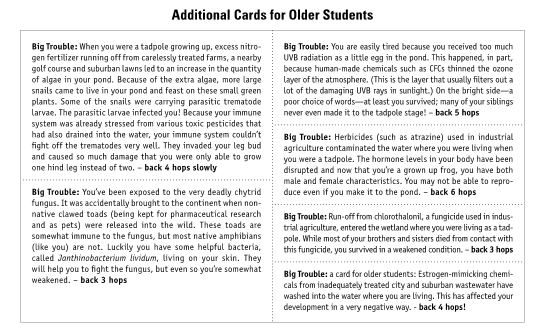Amphibians and Two Game Structures

Originally appears in the Summer 2011 issue
Why should children listen when we offer to share information about nature? If we tell them clearly that we’re trying to transmit TRUE stories about the world in which they live, will they gain interest and actually pay attention? If we explain to them that knowing about non-human beings is vital because, in fact, their own individual lives are linked in profound ways to the lives of all inhabitants of the planet, will they try to understand? If we urge them to listen because we are parentally-sanctioned ‘Teachers’ and their families and communities want them to learn what we’re trying to teach, will this motivate them? Perhaps it will if we’re lucky. More likely it will not.
Our rationales and appeals to youngsters’ sense of wonder and connection with the natural world may go unheeded, depending on each child’s emotional context and individual history of socialization. If we try to catch a child’s attention by threatening negative consequences, the attention we’ll get will be sullen and resentful—not listening or learning of the best sort. However, if we invite students to play a genuinely engaging game with their friends that respects their developmental priorities, aren’t they more likely to follow along? Won’t a few more actually try to tune into the stream of words and distill these sounds into ideas and actions? I would wager that they will, and here are examples of two simple, almost archetypal games which together can be adapted to create opportunities for empathetic and enjoyable learning about animal life on earth.
Frog Fortunes
Following a field trip to a wetland or some class time spent studying various amphibians, give your students an opportunity to try this activity. It’s best conducted outdoors but can easily be adapted to the confines of a classroom as needed. Students form teams that impersonate various species of frogs. Three or four frog teams work well, but if it’s a small class, two will suffice (teams need not be evenly divided). The assortment that I enjoy includes: green frogs, bullfrogs, wood frogs and spring peepers. Children have to choose which frog they’ll pretend to be. Knowing this is an incentive for them to listen carefully as one introduces the characteristics of each species.
Once students have chosen their species, the newly minted ‘frogs’ assemble into species groups along a prearranged starting line. At this point, I usually teach an approximation of each frog’s call: green frogs have a banjo-like “gunk”; bullfrogs sound like “jug-a-rum” ; wood frogs “quack”; and spring peepers emit a high-pitched, sustained “peeeeep”.1 After discussing the role of calls in frog communication, I explain that these calls can serve as each team’s ‘cheer’. I encourage the youngsters to use these sounds as they joke around and build team spirit.
Next, we explain that each group of frogs has just awakened from winter hibernation. The groggy frogs are about to begin their perilous journey towards a peaceful ‘pond’ (the designated finish line). There, the frogs will feast on various small invertebrates, find mates and eventually produce the next generation of froglets. Progress towards the breeding pond is determined by drawing from a set of randomly arranged Frog Fortune Cards (see the cards at the end of this article). These cards describe some of the helps and harms real frogs might face during such travels.
The moderator (the teacher, or better, a student who likes to read and be dramatic) draws a card for each team and team members hop forwards or backwards in unison according to the card’s instructions. (The cards provided apply to all frog species—they present events which might befall any type of frog.) Continue to draw cards for each group of frogs, always in the same order, as the teams progress across the field. The first team to reach the pond is victorious.
Extension
Have students, independently or in teams, research the lives of frogs. Students can then compose their own event cards based on what they have learned. Youngsters could also create life-size frog illustrations for the cards before or after playing. This is a very effective way for them to assimilate and share new knowledge about all sorts of living creatures.
As an activity, Frog Fortunes tends to be rather controlled (except for the unpredictable sequence of event cards). The former quality can be an advantage, particularly when you are dealing with new students (such as a group visiting a nature center) or with youngsters who are being a bit obstreperous. One can, however, make the game more enjoyable—and not merely didactic—by emphasizing its competitive, team-bonding dimensions and the imaginative possibilities of pretending to be a frog. Urge the various frog species to call proudly in chorus prior to the reading of their Fortune Cards. Read the cards themselves theatrically.
When the youngsters are actually playing, these directions have proved very helpful: Encourage the students to make astonishing (yet fair) leaps forward. Capture the interest of the more athletic individuals by allowing each team to move forward to the point that was reached by the team’s very best hopper. This policy helps keep each species group together on the playing field and prevents the kids who don’t jump particularly far from straggling behind and being singled out in a negative way. When one team finally arrives at the “pond of destiny”, conclude the game with a multi-species celebration featuring supportive frog vocalizations—not just from the winners.
Traveling Frogs
After one or two rounds of Frog Fortunes, try a game with more opportunities for socializing, free choice, and exercise. Traveling Frogs is a game based on the traditional game of “tag”. Describe to your students a scenario in which the various frogs travel to a wooded area, damp meadow or pond to feed and breed. Establish a finish line to represent this enchanting destination. As before, the frogs must compete to reach the finish. This time, however, they will have to reach their goal individually, and they must avoid being tagged by one or more “Dangers” who are moving across the grounds. The youngsters could brainstorm to determine who these dangers are. Perhaps they will decide on Great Blue Herons, Minks, River Otters, Marsh Hawks, Saw-whet Owls or even cars, lawnmowers or toxic chemicals.
Students who volunteer or are chosen for these roles should try, if possible, to imitate the enemies being portrayed. Can they imagine some sound or gait that would characterize their particular danger? How do you imitate a pesticide spray? Line up the designated Dangers and describing their frightening characteristics to the Frogs before you start the actual game. This is an opportunity to pass along additional knowledge, since students will be listening as they try to register which of their classmates they’ll need to outrun. Select volunteers to serve as game monitors, who will observe the game to make sure proceedings go fairly. This is a perfect role for any student who cannot run.
Gameplay begins with all the frogs lined up at one point. The teacher announces that Spring has arrived and the travelling Frogs may “GO!” Like most games with a tag format, the point is essentially to avoid being tagged by the “Dangers” while dashing to the finish line.
The monitors must ensure that all Frogs play fair and ‘die’ (move to the sidelines) once tagged. Captured frogs must stay there until the game finishes. Play begins and continues until all the frogs have either reached the designated wetland or been tagged. At this point, the Danger who has captured the most frogs might receive special recognition for being the fiercest or fastest of enemies. Words of commiseration are offered to those frogs who have fallen and praise is awarded to those who have reached the forest, pond or meadow.
Reflections:
As you can imagine, these two distinct games can easily be reconfigured to represent other natural scenarios. For my own classes, I’ve used the basic structure of ‘prescribed movements towards a goal’ to model the challenges confronting pollinators trying to gather food from a blossoming meadow or sprouting seeds trying to grow in a garden. During inclement weather, this kind of game can be adapted for use indoors (substitute steps for leaps, use symbolic checks on a blackboard or screen, or even use counters on a board to represent each team’s progress). The ‘tag’ format, with modifications, works beautifully in bird migration games, as described by Lingelbach and Purcell in “Migration Obstacle Course” (p. 144), yet is obviously well suited for any predator-prey or creature-danger dynamic. Project Wild’s “Quick Frozen Critters” (pp. 122-123) adds some interesting complexities to the basic game premise, including a requirement for players to gather food tokens as they try to reach the goal. Once children are accustomed to playing games with these general structures, they can easily invent their own versions. Students can share and viscerally reflect on research that they’ve done by transforming their findings into event cards for ‘prescribed movements towards a goal’ activities or perhaps complex variations of tag.
By challenging young people to create and dramatize real-life dilemmas and conflicts in a game, we give them the occasion to vividly empathize with the lives of other beings. This can fortify their sense of compassion and connection with other forms of life.
In each game’s highly charged peer-to-peer interaction, children learn how to coordinate quick strategic decision-making with large motor movements – a good challenge for their brains’ executive functions. Moreover, the games chasing format allows students to participate in significant physical exercise, especially when played outside. In both game formats, youngsters can build stronger interpersonal skills as they learn to compete and cooperate within a rule-governed social structure. And youngsters are reinforcing and expanding their real-life social networks during these games. By entwining awareness of natural history and science with enjoyable social and physical activity, instruction of this kind can promote the assimilation of new information both intellectually and emotionally. Additionally, games of this sort are more respectful of collectivized youngsters’ developmental needs and proclivities than are other necessary but sometimes aversive techniques such as classroom reading, passive video presentation, or worse yet – lectures.
When games of this kind are part of a teaching program, even if students forget many of the precise details of the natural history scenarios, at least they retain a pleasant memory of running across fields with their peers in the fresh air. They’re not alienated from the educational enterprise, and by the end of class, they’re a little more physically fit and healthy just from having fun in the sunshine or under the clouds.
References
Blaustein, A. and Bancroft, B., “Amphibian population declines: evolutionary considerations”, BioScience 57:5 May 2007, pp. 437-444.
Davidson, C., “Declining downwind: amphibian population declines in California and historical pesticide use”, Ecological Applications 1, 2004, pp.1892-1902.
Diamond, A., (Radio interview conducted by Krista Tippet with Dr. Adele Diamond concerning learning, the arts, dramatic play, and the educational implications of recent research about brain development and function) <http://being.publicradio.org/programs/2009/learning-doing-being>, Accessed December 16, 2010.
Elliot, L., Gerhardt, C. and Davidson, C. The Frogs and Toads of North America, Houghton Mifflin, 2009.
Lingelbach, J. and Purcell, L., Hands-On Nature, Vermont Institute of Natural Science, 2000.
Milius, S., “In field or backyard, frogs face threats”, Science News 178, 2010, p. 28.
Myers, P. et al., “The Animal Diversity Web”, <http://animaldiversity.org>, Accessed December 18, 2010.
NASA Earth Observatory (July 8, 2002), “Deformed frogs form when parasites and pesticides combine”, <http://earthobservatory.nasa.gov/Newsroom/view.php?id=22544>, Accessed December 16, 2010.
Project WILD, “Quick Frozen Critters” in Project Wild: K – 12 Curriculum and Activity Guide, Council for Environmental Education, 2002, pp. 122-123.
Rex E., “Amphibian skins: Could bacteria carried by amphibians save them from extinction?”, Scientific American, July 12, 2010, <www.scientificamerican.com/article.cfm?id=skin-fight-bacteria-frogs>, Accessed September 19, 2010.
Tyning, T. F. A Guide to Amphibians and Reptiles, Little, Brown and Co., 1990.
University of California – Berkeley, “Pesticide atrazine can turn male frogs into females”, Science Daily, March 1, 2010, <www.sciencedaily.com/releases/2010/03/100301151927.htm>, Accessed September 19, 2010.
1 Recordings of frog vocalizations can be found on-line at sites such as the University of Michigan Museum of Zoology’s Animal Diversity Web: <http://animaldiversity.ummz.umich.edu/site/Topics/FrogCalls.html> or in printed sources such as the book and compact disc combination The Frogs and Toads of North America—see the References section of this article.
Download the PDF here.
If you are not already a subscriber, please subscribe to read the full article
Edith Couchman teaches art and environmental science for the Beaver Brook Association in Hollis, New Hampshire, and at Maple Dene Elementary School in Pepperell, Massachusetts.
Leave a Reply
You must be logged in to post a comment.







